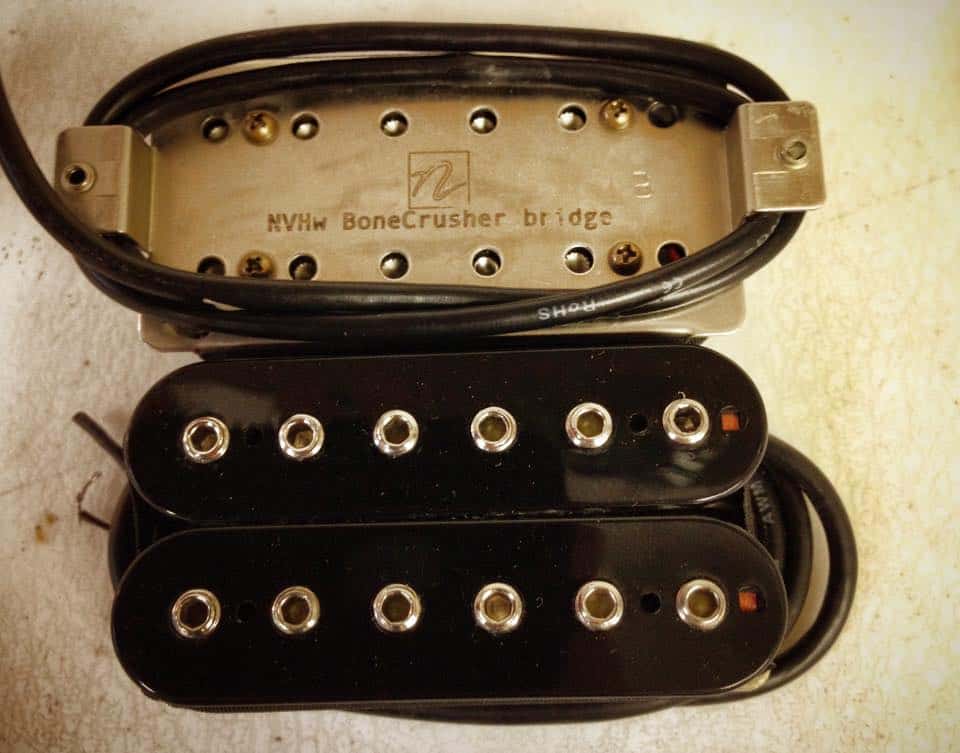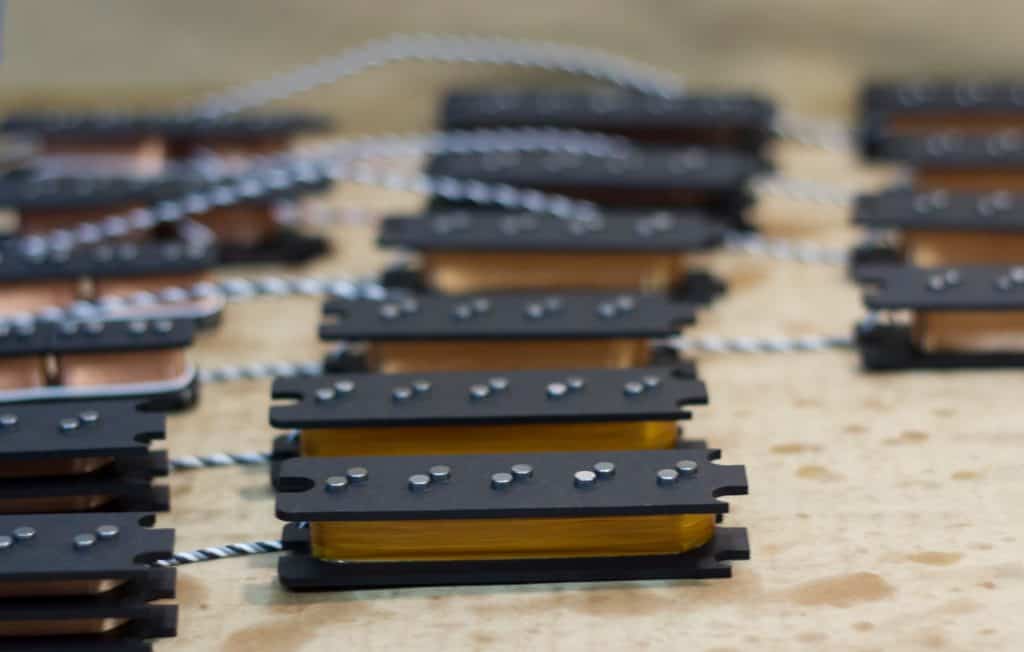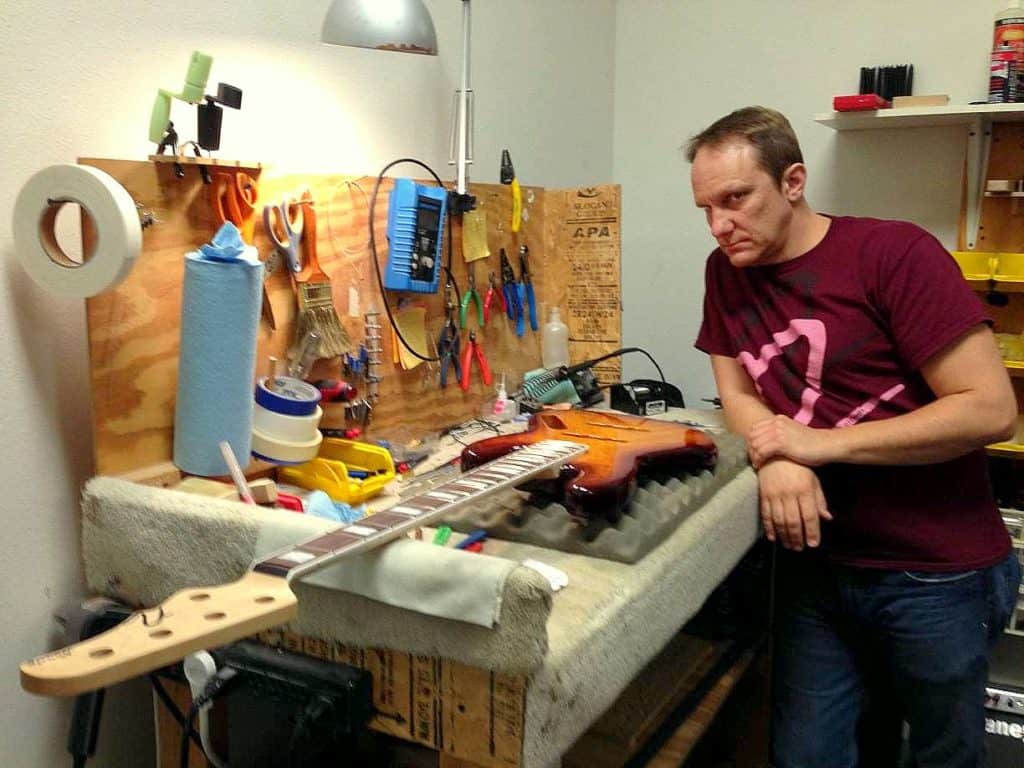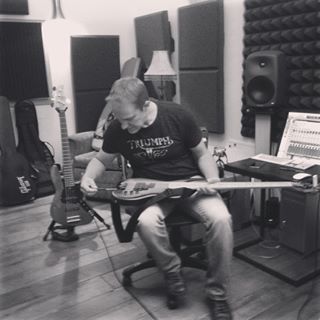
2019 Update: Check out the curly maple wall paneling we made for Carey Nordstrand’s ramen restaurant here.
Apple delivers a great customer experience through products that are not meant to be modified. How does fitting Nordy instruments with Nordstrand pickups allow you to control your customers’ sound experience?
I think that pickups are one of the biggest components of tone. So putting our pickups in our basses really gives us a handle on how they will sound. Even to the point of making suggestions to push things in a desired direction after the bass is completed, especially if the customer has a specific idea of what they want.
Guitar Building Secrets?
Is there one particularly critical step in instrument production? One that separates top tier shops from the others?
No, I don’t think there is one thing that makes a difference and I think that’s why making instruments that are top notch in all aspects is so challenging. A great bass or guitar is an aggregation of many steps and choices over the process of the build. There are many many steps involved and they all build upon the previous one. So to really be exceptional, the instrument has to have excellent fit and finish, a great feel in the hands, and it has to be inspiring tonally. Hitting all three of these is not something that happens easily.
What is the most under appreciated luthiery tool in your workshop?
The most under-appreciated tool is probably a simple sanding block that is shaped to be very ergonomic. Very functional and used a lot.
Favorite Guitar Builds
What’s your favorite of your Nordstrand builds?
Currently, I’m enjoying my personal Tele style guitar. I’ve been writing and recording a lot and that particular guitar is full of great sounds and it feels great to play.
What’s your favorite non-Nordy guitar?
My favorite non Nordy is probably my Goodall TOM acoustic guitar. It’s fantastically built and has an incredibly lush and full sound. Someday I want to get into building acoustic guitars and that one is great to have around. Inspiring.


If there were no manufacturing or technological constraints what would be a game-changing modification to the pickup?
Good question. I often try to think in these terms to come up with new ideas. I guess I don’t really have an answer right now. But getting into 3D printing would probably allow some crazy ideas to come to light.
Chambering guitars helps reduces instrument weight but how does it affect sound quality in an electric instrument?
I’m generally not a huge fan of chambering a bass. It tends to make the sound a bit too scooped and clean sounding for me. So I shoot for light weight alder and ash. I like my 5 string J basses to end up at around 9-9.25 pounds. They sound best to me at that weight.
What is your favorite wood for sound and appearance?
I prefer alder and some type of rosewood these days (with a maple neck). But I really want to make myself an ash maple Tele in the early 52-ish style.
Luthier Sacred Cows
What doesn’t Carey Nordstrand like about neck-through instruments?
I think neck through instruments have a rubbery character to the sound. Now, take that with a huge grain of salt, because I haven’t played a lot of neck through instruments. But I like the punchy character of bolt on or set neck construction more.
Any commonly held beliefs regarding pickups that you believe to be incorrect?
The biggest misconception is that DCR is equivalent to output. For a given style of pickup that is generally true, but compare a set of FatStacks to a set of Big Singles and the Big Singles are a fair bit louder even though their DCR is only a little more than half that of the Stacks.
In the world of boutique luthiery, there’s a mojo associated with small batch, non-CNC carved instruments. Hand-wound pickups tend to be brought to market in a similar way. How much is marketing verses reality?
Hand made = time and care according to general perception. So it’s a natural way to market if that’s what you do. I think it’s also generally the case that hand made = quality. But it’s certainly not the rule.

My own approach is that I want my vision of what makes a great instrument or pickup to be realized in the best way possible. For me that means using cnc lasers, routers, and winders. These tools, when used carefully and creatively, can provide the quality typically associated with a “hand made” approach in a very consistent and repeatable manner. I think this is VERY important for pickups. I want my 300th NVT A3 neck pickup to sound just like the initial development sample. CNC winding allows that as long as the rest of the variables (wire, magnets, tension) remain consistent. Wind pattern has a very obvious effect on tone and I have a hard time believing that a hand winder can consistently wind pickups that sound the same.
Wood Combinations
Are there optimal wood/pickup combinations for sound or is the effect of one on the other too small to consider?
Optimal is a loaded word here. We can certainly pair up pickups and woods for a specific sound though. And it usually starts with traditional recipes, like an ash maple 70’s J bass with 70’s style single coils. It really depends on what the player wants to hear, and all the parts of an instrument are factors. I believe pickups are near the top and woods a little further down.
If a player is looking to change his/her sound by swapping out pickups, how should they go about it?
Well, start with a screwdriver and a soldering iron. Just kidding. I think it’s best if there is a target to shoot for. I always ask players who they like in terms of sound. A couple names can take us a long way to finding the right pickups. It’s also good if I know what they are using currently and how they think it’s not working for them.
Instrument Hardware & Accents
Are there any sonic considerations when choosing pickup cover material or is it strictly a visual consideration?
Wood and plastic covers are essentially sonically invisible. Er, inaudible. But when we get into metal it gets a lot more complicated. Most builders use nickel silver covers these days as they are the most sonically transparent. But I believe one can make a good sounding pickup with brass covers as long as the impact of the cover is designed into the finished product.
When you first started building instruments, what were you hoping to accomplish?
Probably what a lot of builders wanted, which was to have a nice instrument because I certainly couldn’t afford to buy one. That quickly evolved into the realization that I could do the same thing for other players. – offer a great bass for a good price. Funny how that works though, I still couldn’t afford to have a good bass, even one I made, for many years.
Building a Luthiery Business
What obstacles did you run into the first year?
The hardest thing was doing it all by myself. It was extremely hard to build the basses and manage the communication for the potential orders and then for the actual orders. If I spent a couple hours on the phone with a customer I felt terrible about not getting any woodworking done. It’s really a lot to deal with, especially when you become the flavor of the month on the forums. It can really consume you.
What’s your personal favorite instrument? What does the mastermind behind Nordstrand look for when he wants to relax and play?
I can’t pick just one. I have 4 instruments that I made for myself and I adore each of them in their own way. My 2 guitars are a strat style (vS) and a tele style (vT). I have our A3 (alnico III) NVT pickups in the vT and the thing is absolutely amazing. I was grabbing that one the most when I’d plug in to play and write. But last week I put a set of our new NVS A3 pickups in my vS guitar and for the moment that one is getting all the attention. For basses, I have a NJ5 I made for myself about 10 years ago. It has a set of Big Single A3 pickups in it and it’s great for that big broad J inspired sound. The other bass is one of our vP5’s. Again, I put an alnico III version of our NP5 pickup in it and it’s just fantastic. It covers the ground that the NJ5 doesn’t, and it’s just the fattest thing ever. Organic, lush, and somehow still open enough not to take too much space in a mix. Actually, that’s kind of the theme of my work. I’m always focused on how my pickups and instruments will sound in a mix and I want them to sound beautiful and inspiring.

Was there anyone in the instrument/pickup design world who was particularly helpful when you were trying to make a name for yourself?
Specifically helpful? Hmmm. Well, I came up working for Steve Azola and John Suhr. They were definitely helpful in that they wanted me to do my best work for them and they showed me what I needed to know to do that. Beyond that I eventually found that I had to be creative and solve problems of my own accord. Those guys both know a ton about what they do, and they can teach you a lot of that. But at some point one has to find one’s own way. Take what was taught and learned and move it in one’s own direction. I think I did that pretty well and that’s what really made my work compelling for my customers.
Nordstrand Audio: Success in the Music Business
After starting your own company, was there a moment where you reached critical mass and felt success had arrived?
That feeling comes and goes, even 12 years in. There are moments where I look back and am amazed at what has happened. And then there are moments where things get rough and I wonder why I bothered and for a moment I think maybe it would have been easier working for someone else. But then I come to my senses. I really can’t say there’s much I would change. Life will constantly give you opportunities for learning and growth if you are open enough to see them. The hard times are when you get stuck in resisting what happens. Find a way to accept these and learn from them and things will evolve, usually in a way that one would say is better.
Guitar Custom Shop Business
What is the state of the boutique instrument market right now? Is it a good time to be making high-end instruments?
Man it’s really tough to build expensive basses these days. I have several friends in this game from the most established to the greenest of startups. No one is getting rich doing this. If you want to own a killer high end bass it’s a great time to buy. But to make a living at it is extremely difficult.
Have you ever looked at a non-Nordstrand pickup design and thought “I wish I thought of that?”
Sure, lots of times. My friend Howard Ulyate has come up with some really creative stuff. But there’s always a lot of opportunity out there to really push things in new directions. I’m hoping we can acquire a 3D printer soon. That will unleash a lot of possibilities.
Carey Nordstrand: Musician
Tell us a little about Carey Nordstrand the musician. I understand you’re in a band.
I am currently working on a couple projects, yes. One of them is “mine” in that it started with a group that I put together. I was playing bass and writing in that one. We lost our drummer recently though and the guitar player lives in the OC so it’s tough for him to get out here. So at the moment, it’s really just me and my singer Ed writing and recording material. We want to get a bunch of songs finished and out there and then hopefully put a full band together to support the material.
The other one is a band called the Sotobots. The main guy and singer for that band and I are also putting together material in the studio, with contributions from the lead guitarist as well. The same drummer I had was in this band too so we’re not in a playing out position at the moment. It’s funny because I was getting set to take the drumming slot and then we lost our bass player.
I also write and record my own material. I’ve been taking voice lessons for 3 months now and have improved a lot. My dream is to have music that I wrote, sang, and played drums, guitar, and bass on. Just gotta keep at it. At some point the material will be good enough to share. There are some things that I an working on out there on my Soundcloud page. A search should turn it up.
Wood Walls and Recording
You just expanded your facility and have a new recording studio. What made you decide to build a studio?
Having a dedicated place to create and record music has been something I’ve needed to do for as long as I can remember. I’ve had ProTools on my computer for probably 15 years. And for all that time I’ve at least had a basic audio interface. But I’ve always struggled with setting things up in a corner of my home and then trying to be creative with life happening all around. It never went that far. Having a nice organic dedicated space is amazing. It’s like a sanctuary in a lot of ways. It just stays there and is ready when I am.
Your studio room has parallel walls which can present sound cancellation challenges. How did you deal with that?
How important is the studio environment in setting the vibe for a successful recording session? How does a musician’s state of mind affect the creative process?
How important it is to have a correctly setup room. Can you use an EQ to tune a room with a less than optimal setup?
Custom Studio Design & Flooring
What about the studio floor? You installed wide-plank salvaged Quartersawn Red Oak flooring. Was that for feel and ambiance or were there sound considerations?
The original concept was that of a barn floor. Or yeah, probably a rustic cabin.
Red Oak is not a traditional instrument wood.
How did you like working with Red Oak?
Acoustic Math
We spoke about room ratios and how they affect the overall quality of sound. What kind of math were you doing when you laid out the new studio?
You also designed and installed hardwood sound diffusers. How do they help?
The diffusers scatter the sound and break up reflections so the room sounds more even. I only had enough wood to build 2 panels so I placed them on the wall opposite the monitor position and they really made an obvious difference. There’s not any perceptible slap or echo thanks to those panels and the handful of other more simple panels I made.
What type of musicians typically record at your studio?
Mostly it’s just been my friends – local indie rock type stuff. It’s a very special place to me so I haven’t made it generally available. I don’t want it to get thrashed.
What is the hardest sound to capture authentically in a studio?
I can’t say there really is one, but drums are pretty tricky and I’m still learning a lot about how to get what I hear in my head into the computer. But all instruments present their challenges. It’s a matter of listening to what is in the room and then choosing and setting up mics to get the best sound recorded for the particular track. I think an open minded approach is always ideal and gets the best results.
Audio Recording Equipment
What kind of equipment do you have in the new studio?
I am really deep into the Universal Audio Apollo and the UAD plugins. They are phenomenal creative tools for what they cost and I really think I’m only limited by my abilities and not by any sonic limitations. I also use ProTools 11 on a Mac Pro I and love it. I have a handful of great guitar amps and of course a few good bass rigs, including my prototype Nordstrand Audio stuff. There are a couple drum kits. Also some killer basses and guitars as mentioned above. And I’m really liking the Blue mics right now. I have several and feel pretty spoiled for the options they afford. Really great stuff.
Your current studio was originally a commercial space. What was the biggest acoustic issue you had to address in the remodel?
I think the floor was probably the biggest thing. That and the parallel walls. I was a bit worried when we got started that the parallel walls would be a tough problem to deal with, but in the end it wasn’t that big of a deal.
The Recording Studio Vibe
What is the vibe you want musicians to feel when they walk into your studio for the first time?
I want them to simply let out a nice deep relaxed breath and feel like they can let down a bit. A bit like coming home in an ideal sense. “Come in, relax, have a seat. We’re about to do one of the best things around – make music!”

